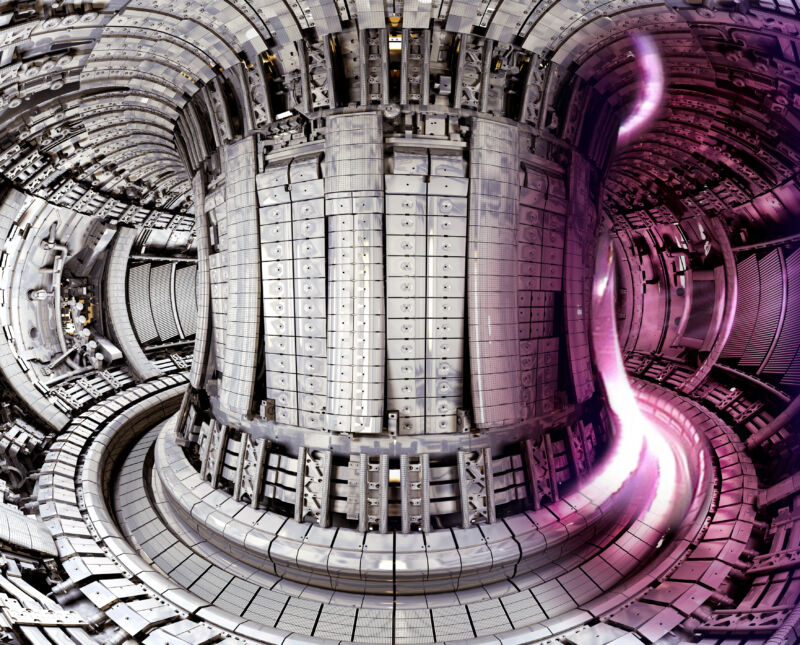On Wednesday, the EUROfusion consortium announced that the Joint European Torus (JET), located near Oxford in the UK, had set a new record for released energy. Over the course of a five-second "pulse," 59 megajoules of energy were released, double the previous record for tokamak fusion set at JET in 1997.
Despite the impressive numbers, the results are still well short of the break-even point where the fusion energy released would match the energy input required to trigger the fusion. Still, the work provides an important validation of the approach being taken at the next major fusion project, the International Thermonuclear Experimental Reactor, or ITER.
Two ways to fuse
Fusion takes place when atomic nuclei are brought close enough together that they merge, creating a heavier element. It's the process that powers stars, and it could produce vast amounts of energy from small amounts of hydrogen isotopes if we could reproduce the temperatures and pressures found in stars here on Earth. So far, we've taken two main approaches to the process.
In the first, many high-powered lasers deliver an extremely intense burst of energy that crushes and heats a small pellet of hydrogen isotopes, producing a short burst of fusion. This is the approach taken at the National Ignition Facility, which has put up some impressive results in terms of the amount of energy produced. But the released energy comes in an extremely short burst, after which the lasers need to be re-cycled and the target needs to be replaced. By the time the system is ready to create another burst of fusion, all the heat generated by the first has dissipated. It's not clear how to create the sort of sustained release of energy that will be needed for something like a power plant.
The alternative approach involves creating a high-energy hydrogen plasma and then using intense magnetic fields to contain and compress it. This is generally done in a toroidal structure called a tokamak, an approach developed in the Soviet Union (though there are alternative structures). While it doesn't produce the same sort of burst of fusion, a tokamak contains a lot more fuel and has the potential to sustain fusion reactions for long enough to extract useful energy.
Right now, the most powerful tokamak on the planet is JET, which holds the record for highest output: 22 megajoules, set during an experimental run in 1997. In recent years, JET has been used as a testbed for the technologies and materials that will go into ITER, a much larger tokamak that is expected to finally reach break-even and pave the way for the first demonstration fusion power plant.
As such, successes at JET provide important indications that ITER is likely to achieve the milestones expected of it.
World records
While it's possible to run sustained reactions in tokamaks, JET isn't large enough to reach this sort of stable state. Instead, it is being operated in five-second pulses in which it creates conditions where fusion can start and then ramps back down again. This setup allows researchers to test materials for the tokamak and different configurations of its magnets to determine how they affect this pulse of fusion. Since the design is largely similar to that of ITER, these pulses can give real-world data to validate the models we have of what will happen inside ITER once it is switched on.
And that's why this energy milestone is important. Set up to reflect the design of ITER, and with the mix of deuterium and tritium fuel that will be used there, JET made the largest sustained fusion reaction yet.
"The record—and more importantly, the things we’ve learned about fusion under these conditions and how it fully confirms our predictions—shows that we are on the right path to a future world of fusion energy," said Tony Donné, the program manager at EUROfusion, which runs JET. "If we can maintain fusion for five seconds, we can do it for five minutes and then five hours as we scale up our operations in future machines."
After years of delays, ITER is now expected to begin experimental runs in 2025. Unlike JET, ITER is expected to go well past the break-even point and host self-sustaining fusion reactions in which the energy produced remains above the energy needed to control the reaction.



3175x175(CURRENT).thumb.jpg.b05acc060982b36f5891ba728e6d953c.jpg)

Recommended Comments
There are no comments to display.
Join the conversation
You can post now and register later. If you have an account, sign in now to post with your account.
Note: Your post will require moderator approval before it will be visible.